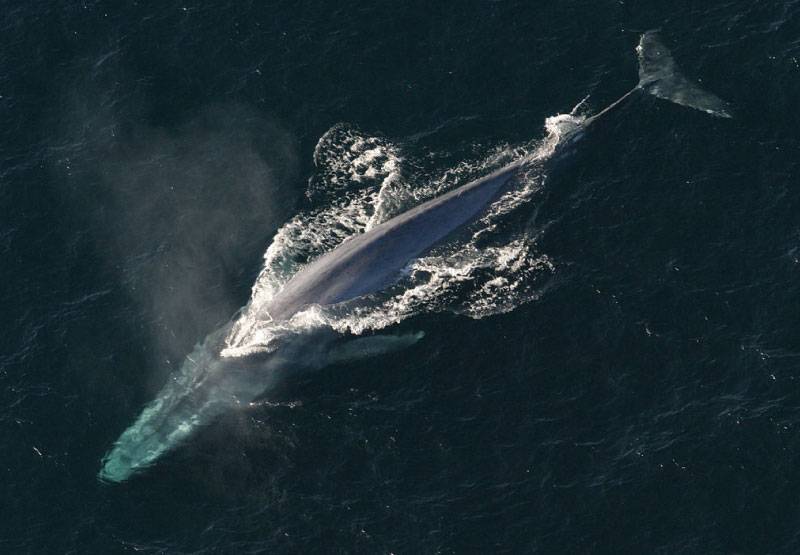
A list of the different types of whales that includes every living whale species, from the smallest (the dwarf sperm whale), to the largest (the blue whale).
Page Contents
Interactive Table Of Whale Species
What Is A Whale?
Whales are marine mammals belonging to the group Cetacea, which also includes dolphins and porpoises. Whales are known for their large size, with many whale species weighing several tonnes.
Although descended from land animals, whales are fully adapted to aquatic life, possessing streamlined bodies for efficient swimming, flippers for maneuvering, and a paddle-like tail, known as a fluke, for propulsion.
Despite living in the ocean, whales are air-breathing animals and therefore have to surface periodically in order to breathe via a blowhole on top of their heads.
Whales are intelligent animals, known for their complex social structures and communication systems, including the distinctive sound of whale song.
Two Main Types Of Whales
There are two main types of whales: baleen whales of suborder Mysticeti, and toothed whales of suborder Odontoceti. Baleen whales are filter feeders that consume vast amounts of small prey such as krill and bait fish. Toothed whales typically hunt larger prey such as fish, squid and even other marine mammals, using echolocation.

The list of whale species below contains information on every recognized whale species. In compiling this list, we consulted both the Catalogue of Life and the Mammal Species of the World databases. The conservation status of each species comes from the IUCN Red List, and is correct at the time of publishing.
Note that the list does not include dolphins (including the killer whale), which, despite being toothed whales, are usually treated as a separate group. You can see a list of every dolphin species on this page: Types Of Dolphins.
Whale Species List
- Andrews’ Beaked Whale
- Antarctic Minke Whale
- Arnoux’s Beaked Whale
- Baird’s Beaked Whale
- Beluga Whale
- Blainville’s Beaked Whale
- Blue Whale
- Bowhead Whale
- Bryde’s Whale
- Common Minke Whale
- Cuvier’s Beaked Whale
- Deraniyagala’s Beaked Whale
- Dwarf Sperm Whale
- Fin Whale
- Gervais’ Beaked Whale
- Ginkgo-Toothed Beaked Whale
- Gray Whale
- Gray’s Beaked Whale
- Hector’s Beaked Whale
- Hubbs’ Beaked Whale
- Humpback Whale
- Narwhal
- North Atlantic Right Whale
- North Pacific Right Whale
- Northern Bottlenose Whale
- Omura’s Whale
- Perrin’s Beaked Whale
- Pygmy Beaked Whale
- Pygmy Right Whale
- Pygmy Sperm Whale
- Sato’s Beaked Whale
- Sei Whale
- Shepherd’s Beaked Whale
- Southern Bottlenose Whale
- Southern Right Whale
- Sowerby’s Beaked Whale
- Spade-Toothed Whale
- Sperm Whale
- Stejneger’s Beaked Whale
- Strap-Toothed Whale (Layard’s Beaked Whale)
- Tropical Bottlenose Whale / Longman’s Beaked Whale
- True’s Beaked Whale
Table Of Whale Species
| Common Name | Scientific Name | Suborder | Family | Conservation Status | Avg. Length (m) | Avg. Length (ft) | Avg. Weight (kg) | Avg. Weight (lb) | Where Found | |
|---|---|---|---|---|---|---|---|---|---|---|
| Andrews’ Beaked Whale | Mesoplodon bowdoini | Odontoceti | Ziphiidae | Data Deficient | 4.50 | 14.76 | 1300 | 2866.01 | Southern Hemisphere oceans | |
| Antarctic Minke Whale | Balaenoptera bonaerensis | Mysticeti | Balaenopteridae | Near Threatened | 8.50 | 27.89 | 7000 | 15432.34 | Southern Ocean | |
| Arnoux’s Beaked Whale | Berardius arnuxii | Odontoceti | Ziphiidae | Least Concern | 9.75 | 31.99 | 4500 | 9920.79 | Southern Ocean | |
| Baird’s Beaked Whale | Berardius bairdii | Odontoceti | Ziphiidae | Least Concern | 12.00 | 39.37 | 12000 | 26455.44 | North Pacific Ocean | |
| Beluga Whale | Delphinapterus leucas | Odontoceti | Monodontidae | Least Concern | 4.00 | 13.12 | 1500 | 3306.93 | Arctic regions | |
| Blainville’s Beaked Whale | Mesoplodon densirostris | Odontoceti | Ziphiidae | Least Concern | 4.70 | 15.42 | 1000 | 2204.62 | Global tropical and temperate oceans | |
| Blue Whale | Balaenoptera musculus | Mysticeti | Balaenopteridae | Endangered | 24.00 | 78.74 | 120000 | 264554.40 | Global oceans | |
| Bowhead Whale | Balaena mysticetus | Mysticeti | Balaenidae | Least Concern | 18.00 | 59.06 | 100000 | 220462.00 | Arctic regions | |
| Bryde’s Whale | Balaenoptera edeni | Mysticeti | Balaenopteridae | Least Concern | 15.00 | 49.21 | 20000 | 44092.40 | Warm oceans worldwide | |
| Common Minke Whale | Balaenoptera acutorostrata | Mysticeti | Balaenopteridae | Least Concern | 8.50 | 27.89 | 7500 | 16534.65 | Global oceans | |
| Cuvier’s Beaked Whale | Ziphius cavirostris | Odontoceti | Ziphiidae | Least Concern | 7.00 | 22.97 | 3000 | 6613.86 | Global oceans | |
| Deraniyagala’s beaked whale | Mesoplodon hotaula | Odontoceti | Hyperoodontidae | Data Deficient | 4.50 | 14.76 | 1000 | 2204.62 | Indian Ocean, South Pacific Ocean | |
| Dwarf Sperm Whale | Kogia sima | Odontoceti | Kogiidae | Least Concern | 2.70 | 8.86 | 250 | 551.16 | Warm oceans worldwide | |
| Fin Whale | Balaenoptera physalus | Mysticeti | Balaenopteridae | Vulnerable | 22.00 | 72.18 | 70000 | 154323.40 | Global oceans | |
| Gervais’ Beaked Whale | Mesoplodon europaeus | Odontoceti | Ziphiidae | Least Concern | 5.50 | 18.04 | 1300 | 2866.01 | Atlantic Ocean | |
| Ginkgo-toothed Beaked Whale | Mesoplodon ginkgodens | Odontoceti | Ziphiidae | Data Deficient | 4.90 | 16.08 | 1100 | 2425.08 | Tropical and warm temperate oceans | |
| Gray Whale | Eschrichtius robustus | Mysticeti | Eschrichtiidae | Least Concern | 14.90 | 48.88 | 36000 | 79366.32 | North Pacific and North Atlantic | |
| Gray’s Beaked Whale | Mesoplodon grayi | Odontoceti | Ziphiidae | Least Concern | 5.70 | 18.70 | 1200 | 2645.54 | Southern Hemisphere oceans | |
| Hector’s Beaked Whale | Mesoplodon hectori | Odontoceti | Ziphiidae | Data Deficient | 4.20 | 13.78 | 1000 | 2204.62 | Southern Hemisphere oceans | |
| Hubbs’ Beaked Whale | Mesoplodon carlhubbsi | Odontoceti | Ziphiidae | Data Deficient | 5.00 | 16.40 | 1200 | 2645.54 | North Pacific Ocean | |
| Humpback Whale | Megaptera novaeangliae | Mysticeti | Balaenopteridae | Least Concern | 16.00 | 52.49 | 30000 | 66138.60 | Global oceans | |
| Longman’s Beaked Whale | Indopacetus pacificus | Odontoceti | Ziphiidae | Least Concern | 6.50 | 21.33 | 2700 | 5952.47 | Tropical Indian and Pacific Oceans | |
| Narwhal | Monodon monoceros | Odontoceti | Monodontidae | Least Concern | 4.70 | 15.42 | 1600 | 3527.39 | Arctic regions | |
| North Atlantic Right Whale | Eubalaena glacialis | Mysticeti | Balaenidae | Critically Endangered | 15.00 | 49.21 | 60000 | 132277.20 | North Atlantic Ocean | |
| North Pacific Right Whale | Eubalaena japonica | Mysticeti | Balaenidae | Endangered | 15.00 | 49.21 | 60000 | 132277.20 | North Pacific Ocean | |
| Northern Bottlenose Whale | Hyperoodon ampullatus | Odontoceti | Ziphiidae | Near Threatened | 9.80 | 32.15 | 7000 | 15432.34 | North Atlantic Ocean | |
| Omura’s whale | Balaenoptera omurai | Mysticeti | Balaenopteridae | Data Deficient | 10.50 | 34.45 | 14000 | 30864.68 | Indian Ocean, South Pacific Ocean | |
| Perrin’s Beaked Whale | Mesoplodon perrini | Odontoceti | Ziphiidae | Endangered | 4.00 | 13.12 | 1000 | 2204.62 | Eastern North Pacific Ocean | |
| Pygmy Beaked Whale | Mesoplodon peruvianus | Odontoceti | Ziphiidae | Least Concern | 3.90 | 12.80 | 1000 | 2204.62 | Tropical eastern Pacific Ocean | |
| Pygmy Right Whale | Caperea marginata | Mysticeti | Neobalaenidae | Least Concern | 6.50 | 21.33 | 3500 | 7716.17 | Southern Hemisphere oceans | |
| Pygmy Sperm Whale | Kogia breviceps | Odontoceti | Kogiidae | Least Concern | 3.50 | 11.48 | 400 | 881.85 | Global oceans | |
| Sato’s beaked whale | Berardius minimus | Odontoceti | Ziphiidae | Near Threatened | 6.50 | 21.33 | 6500 | 14330.03 | Pacific Ocean | |
| Sei Whale | Balaenoptera borealis | Mysticeti | Balaenopteridae | Endangered | 15.00 | 49.21 | 20000 | 44092.40 | Global | |
| Shepherd’s Beaked Whale | Tasmacetus shepherdi | Odontoceti | Ziphiidae | Data Deficient | 6.50 | 21.33 | 3000 | 6613.86 | Southern Hemisphere oceans | |
| Southern Bottlenose Whale | Hyperoodon planifrons | Odontoceti | Ziphiidae | Least Concern | 7.50 | 24.61 | 5800 | 12786.80 | Southern Ocean | |
| Southern Right Whale | Eubalaena australis | Mysticeti | Balaenidae | Least Concern | 15.00 | 49.21 | 60000 | 132277.20 | Southern Hemisphere oceans | |
| Sowerby’s Beaked Whale | Mesoplodon bidens | Odontoceti | Ziphiidae | Least Concern | 5.50 | 18.04 | 1000 | 2204.62 | North Atlantic Ocean | |
| Spade-toothed Whale | Mesoplodon traversii | Odontoceti | Ziphiidae | Data Deficient | 5.50 | 18.04 | 1400 | 3086.47 | South Pacific Ocean | |
| Sperm Whale | Physeter catodon | Odontoceti | Physeteridae | Vulnerable | 16.00 | 52.49 | 45000 | 99207.90 | Global oceans | |
| Stejneger’s Beaked Whale | Mesoplodon stejnegeri | Odontoceti | Ziphiidae | Near Threatened | 5.30 | 17.39 | 1200 | 2645.54 | North Pacific Ocean | |
| Strap-Toothed Whale / Layard’s Beaked Whale | Mesoplodon layardii | Odontoceti | Ziphiidae | Least Concern | 6.20 | 20.34 | 1300 | 2866.01 | Southern Hemisphere oceans | |
| Tropical Bottlenose Whale | Indopacetus pacificus | Odontoceti | Ziphiidae | Least Concern | 6.50 | 21.33 | 2700 | 5952.00 | Indian Ocean | |
| True’s Beaked Whale | Mesoplodon mirus | Odontoceti | Ziphiidae | Least Concern | 5.30 | 17.39 | 1400 | 3086.47 | North Atlantic Ocean and Southern Hemisphere |
List Of All Whales
Andrews’ Beaked Whale
No Photo Available
Scientific name: Mesoplodon bowdoini
Family: Ziphiidae
Suborder: Odontoceti
Conservation status: Data Deficient
Where found: Southern Hemisphere (specifically the cool temperate waters of the South Pacific)
Length: 4.5-5.5m / 14.7-18ft
Weight: 1,100-1,300kg / 2,425-2,866lb
One of the least-known cetaceans, Andrews’ beaked whale has never been seen alive in the wild. All that we know of the species comes from specimens washed up on the shores of Australia, New Zealand and nearby islands.
This elusive whale species has a robust, spindle-shaped body with a small dorsal fin. Males are generally dark grey with a white ‘cap’ on their head, while females and young are thought to be lighter in color.
Like other members of the beaked whale family, Ziphiidae, Andrews’ beaked whale has a narrow, dolphin-like snout, or “beak”. It has only a single pair of teeth – those of the male take the form of tusks that extend out of the sides of the mouth. Scarring present on the bodies of males indicate that the teeth are used as weapons.
Antarctic Minke Whale
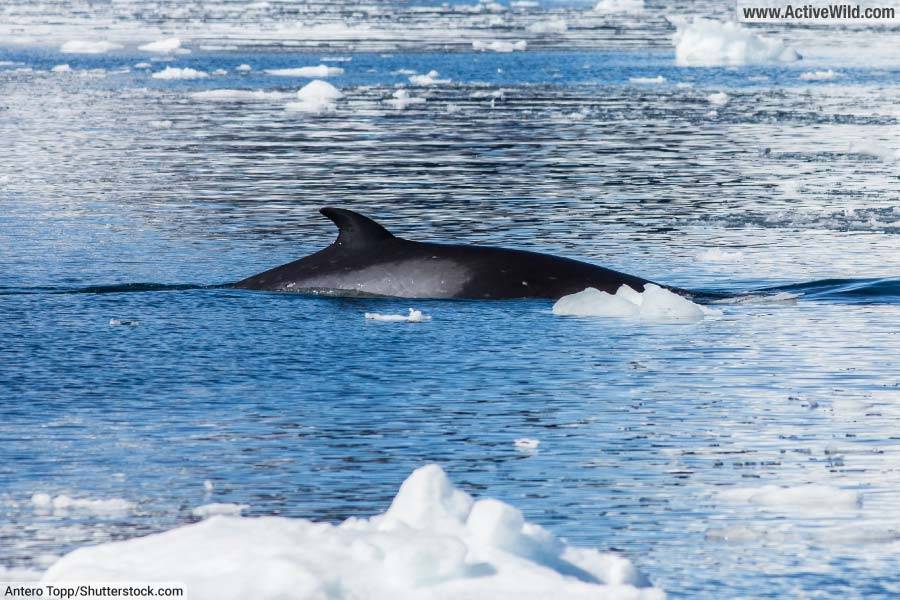
Scientific name: Balaenoptera bonaerensis
Family: Balaenopteridae
Suborder: Mysticeti
Conservation status: Near Threatened
Where found: Antarctic and sub-Antarctic waters
Length: 7.5-10.7m / 24.6-35ft
Weight: 5-10 tons (5000-10000 kg) / 11023-22046lb
The Antarctic minke whale, also known as the southern minke whale, has a slender body and is the third-smallest baleen whale (the second-smallest is the related common minke whale; the smallest is the pygmy right whale).
Due to its small size, low oil yield, and preference for pack ice areas, which are inaccessible to whaling ships, the Antarctic minke whale escaped the attention of whalers when the industry was at its peak. Due to its relative abundance, however, the species is today one of the most commonly-hunted whales.
Arnoux’s Beaked Whale

Scientific name: Berardius arnuxii
Family: Ziphiidae
Suborder: Odontoceti
Conservation status: Least Concern
Where found: Southern Ocean
Length: 9-12m / 29.5-39.4ft
Weight: 9,000-14,000 kg / 19,842-30,865lb
Arnoux’s beaked whale is a large member of the beaked whale family and is known for its preference for deep, cold waters in the Southern Hemisphere.
The species is also known as the southern four-toothed whale; like other members of the genus Berardius it has just four teeth. The whale’s front teeth are visible even when its mouth is closed.
Arnoux’s beaked whale has a cylindrical body with a small, backward-pointing dorsal fin, and is very similar in appearance to the closely-related Baird’s beaked whale.
The species is not well-studied, partly due to its remote Southern Ocean habitat and also because it has not been targeted by the whaling industry.
Baird’s Beaked Whale

Scientific name: Berardius bairdii
Family: Ziphiidae
Suborder: Odontoceti
Conservation status: Least Concern
Where found: North Pacific Ocean
Length: 10-13m / 32.8-42.7ft
Weight: 10,000-12,000kg / 22,046-26,455lb
Baird’s beaked whale is the largest member of the beaked whale family, and the second-largest toothed whale after the sperm whale.
The species is characterized by its long beak and slender body. Like the related, and similar-looking, Arnoux’s beaked whale, it belongs to the genus Berardius.
Whales in this group are known both as four-toothed whales (on behalf of their four teeth), and giant beaked whales (on behalf of their large size in relation to other beaked whales of family Ziphiidae).
Baird’s beaked whale is social and usually found in pods of 5 to 20 individuals. Like other beaked whales it is a deep diver, known to venture to depths of over one kilometer as it forages for squid, fish and crustaceans. Its dives can last up to an hour.
Beluga Whale
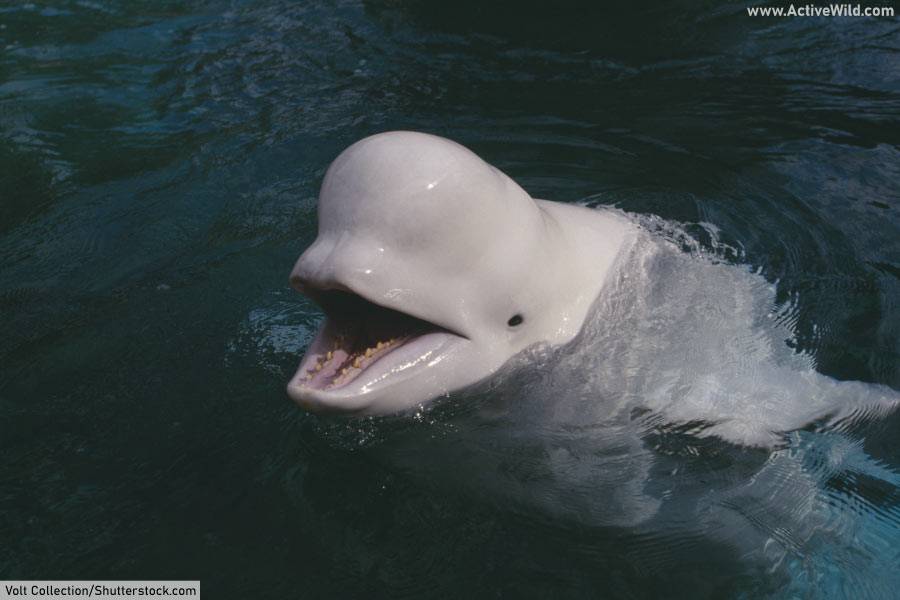
Scientific name: Delphinapterus leucas
Family: Monodontidae
Suborder: Odontoceti
Conservation status: Least Concern
Where found: Arctic and Subarctic regions
Length: 4-5.5m / 13-18ft
Weight: 1100-1600kg / 2425-3527lb
The Beluga Whale, also known as the white whale, is one of the most distinctive types of whales due to its bright white color and the distinctive “melon” on its head, which is used for echolocation.
One of the smallest whale species, the beluga whale is also known as the sea canary due to its high-pitched twitter.
Belugas are extremely social creatures, often seen traveling in pods of 10 or more. It belongs to the family Monodontidae, which contains just one other species, the narwhal.
You can find out more about this species on this page: Beluga Whale Facts
Blainville’s Beaked Whale
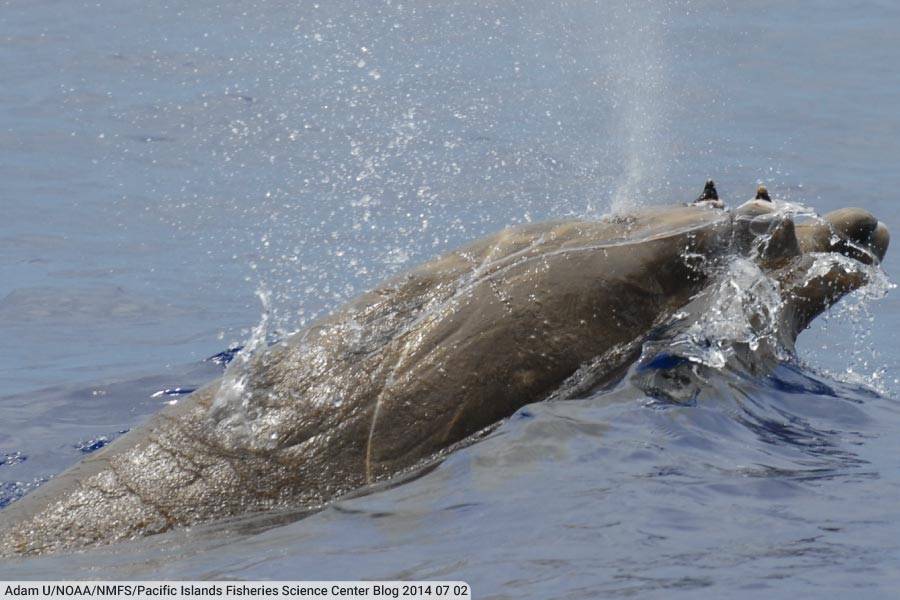
Scientific name: Mesoplodon densirostris
Family: Ziphiidae
Suborder: Odontoceti
Conservation status: Least Concern
Where found: Warm temperate and tropical seas worldwide
Length: 4.4-4.8m / 14.4-15.7ft
Weight: 930-1360kg / 2050-3000lb
Blainville’s beaked whale is a medium to small-sized whale belonging to the beaked whale family, Ziphiidae.
Like all beaked whales, Blainville’s beaked whale has a distinctive pointed snout that resembles that of a dolphin. The bones of Blainville’s beaked whale’s snout are among the densest and stiffest of all animal bones.
The male’s tusk-like teeth project out of the mouth from its lower jaw. The teeth are used for fighting other males, evidence for which is seen in the often scarred appearance of the males’ skin.
Like many beaked whales, Blainville’s beaked whale is difficult to study due to its deep-sea habitat and elusive nature.
Blue Whale

Scientific name: Balaenoptera musculus
Family: Balaenopteridae
Suborder: Mysticeti
Conservation status: Endangered
Where found: All oceans except the Arctic
Length: 25-30m / 82-98.4ft
Weight: 100,000-150,000kg / 220,462-330,693lb
The blue whale is the largest animal ever to have lived on earth, exceeding the size of even the largest dinosaurs. Its tongue alone can weigh as much as an elephant, and its heart as much as an automobile.
Despite its enormous size, the blue whale feeds almost exclusively on tiny shrimp-like crustaceans called krill.
You can find out more about this species on this page: Blue Whale Facts
Bowhead Whale
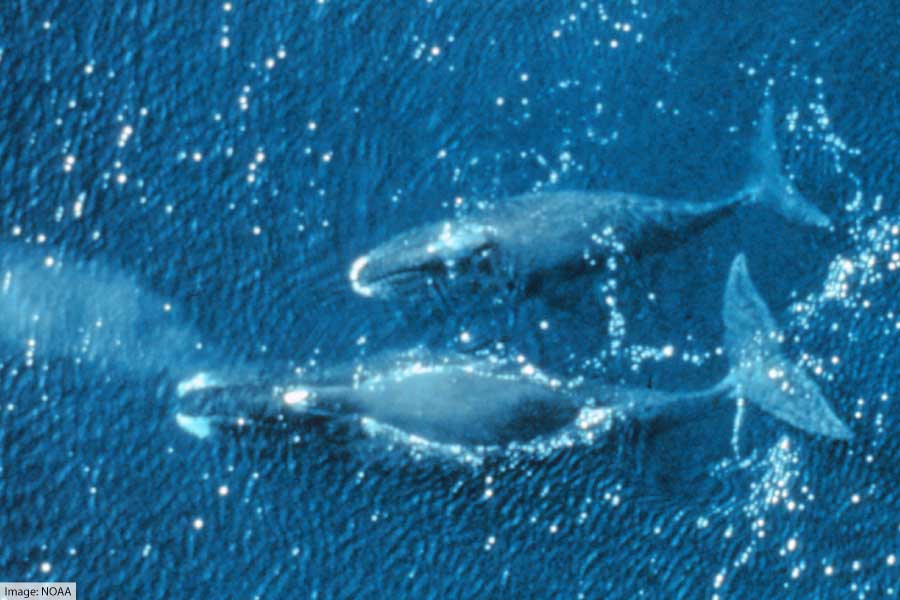
Scientific name: Balaena mysticetus
Family: Balaenidae
Suborder: Mysticeti
Conservation status: Least Concern
Where found: Arctic and subarctic waters
Length: 14-18m / 45.9-59.1ft
Weight: 75,000-100,000kg / 165,346-220,462lb
The bowhead whale, also known as the Arctic whale, is named for its massive curved, or “bowed”, mouth, which is around one third of the length of its body. It is the largest mouth of any animal.
Found in the Arctic, the bowhead whale uses its huge skull to break through the Arctic ice to make breathing holes. One of the longest-living mammals, the bowhead whale can live for over 200 years.
You can find out more about this species on this page: Bowhead Whale Facts
Bryde’s Whale
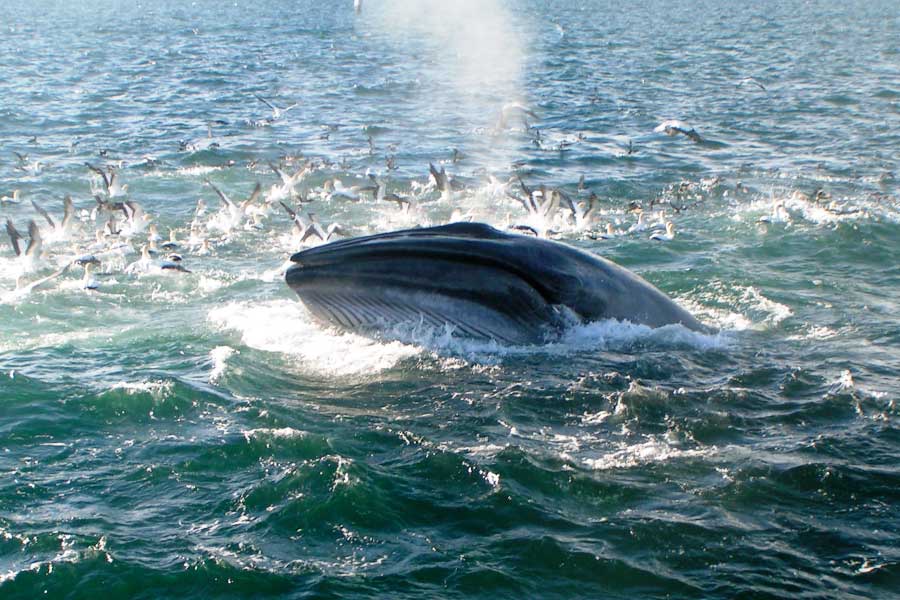
Scientific name: Balaenoptera edeni
Family: Balaenopteridae
Suborder: Mysticeti
Conservation status: Least Concern
Where found: Warm temperate and tropical seas worldwide
Length: 12-15m / 39.4-49.2ft
Weight: 12,000-25,000kg / 26,455-55,115lb
Bryde’s whale is a baleen whale, one of a group of similar-looking, and closely-related species that includes the common Bryde’s whale and Eden’s whale.
Bryde’s whale has a long, slender body, can be identified by the three prominent ridges on its straight snout.
The species is named after Johan Bryde, a Norwegian consul to South Africa who helped establish the first modern whaling station in the country.
Common Minke Whale

Scientific name: Balaenoptera acutorostrata
Family: Balaenopteridae
Suborder: Mysticeti
Conservation status: Least Concern
Where found: Mainly in the North Atlantic and North Pacific
Length: 7-10m / 23-32.8ft
Weight: 5,000-10,000kg / 11,023-22,046lb
The common minke whale is the smallest and most abundant of the rorqual whales, a group of whales characterized by the ridged skin of their throats, which allows the volume of their mouths to greatly expand.
The common minke whale has a sleek body and a sharply pointed snout. Unlike most other whales, it often approaches ships, making it more visible than many other species.
Like all baleen whales, the common minke is a filter feeder, separating food from seawater with its comb-like baleen plates. It feeds on fish, krill and squid, and itself is hunted by the killer whale.
Today, the common minke whale is one of the whale species most commonly-targeted by whalers.
Cuvier’s Beaked Whale

Scientific name: Ziphius cavirostris
Family: Ziphiidae
Suborder: Odontoceti
Conservation status: Least Concern
Where found: Distributed worldwide in deep offshore waters
Length: 5-7m / 16.4-23ft
Weight: 2000-3000kg / 4409-6614lb
The record-breaking Cuvier’s beaked whale has both the deepest and the longest recorded dives of all whales. The species has been recorded at depths of up to 2.992 km / 1.86 miles, and its dives can last for durations of up to 3 hours 42 minutes.
Cuvier’s beaked whale has a robust body, a small head relative to its body size, and a short beak. Only the male’s teeth are visible in the mouth; the species is believed to capture food using suction. Like other beaked whales, the diet of Cuvier’s beaked whale consists mainly of squid.
Deraniyagala’s Beaked Whale
No Image Available
Scientific name: Mesoplodon hotaula
Family: Ziphiidae
Suborder: Odontoceti
Conservation status: Data Deficient
Where found: Warm tropical waters of the western Indian Ocean and central Pacific
Length: 4–5 m / 13–16 ft
Weight (estimated): 1,600 – 2,000 kg / 3,527.4 – 4,409.2 lb
Deraniyagala’s beaked whale is a toothed whale of the beaked whale family Ziphiidae. It is native to the warm tropical and subtropical waters of the Pacific Ocean. With adults reaching lengths of around 5 meters, the species is one of the smallest within the Ziphiidae family.
The species is known only from stranded individuals and very little is therefore known about its behavior and lifestyle.
Dwarf Sperm Whale
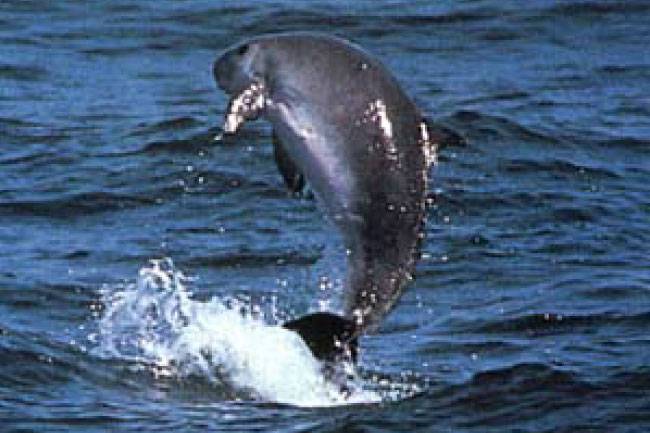
Scientific name: Kogia sima
Family: Kogiidae
Suborder: Odontoceti
Conservation status: Least Concern
Where found: Worldwide in tropical and temperate seas
Length: 2.7m / 8.9ft
Weight: 136-272kg / 300-600lb
Smaller than many dolphins, the dwarf sperm whale is the smallest species of whale.
The dwarf sperm whale has a blunt snout and a small dorsal fin. It has teeth only on its lower jaw, and uses suction to capture prey. When startled, the species ejects a thick cloud of red-brown liquid into the water.
Like its larger relative the sperm whale (the largest toothed whale), the dwarf sperm whale has a spermaceti organ in its head, which is thought to be used for echolocation and possibly for depth control.
Fin Whale
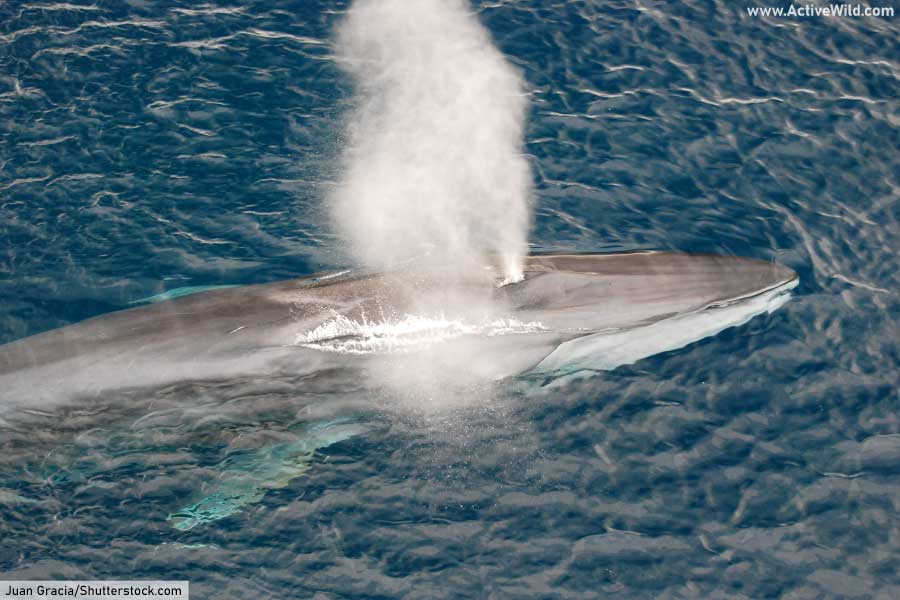
Scientific name: Balaenoptera physalus
Family: Balaenopteridae
Suborder: Mysticeti
Conservation status: Vulnerable
Where found: Global distribution in all oceans
Length: 18-20m / 59-66ft
Weight: 40,000-80,000kg / 88,185-176,370lb
The fin whale, also known as the finback whale, is the second-largest animal after the blue whale. It has a sleek, streamlined body and is known for its speed, often being referred to as the “greyhound of the sea.” Despite its size, it feeds mainly on small schooling fish and crustaceans such as krill.
An unusual characteristic of the fin whale is the asymmetrical coloration of the lower jaw, with the right side being paler than the left.
You can find out more about this species on this page: Fin Whales Facts
Gervais’ Beaked Whale
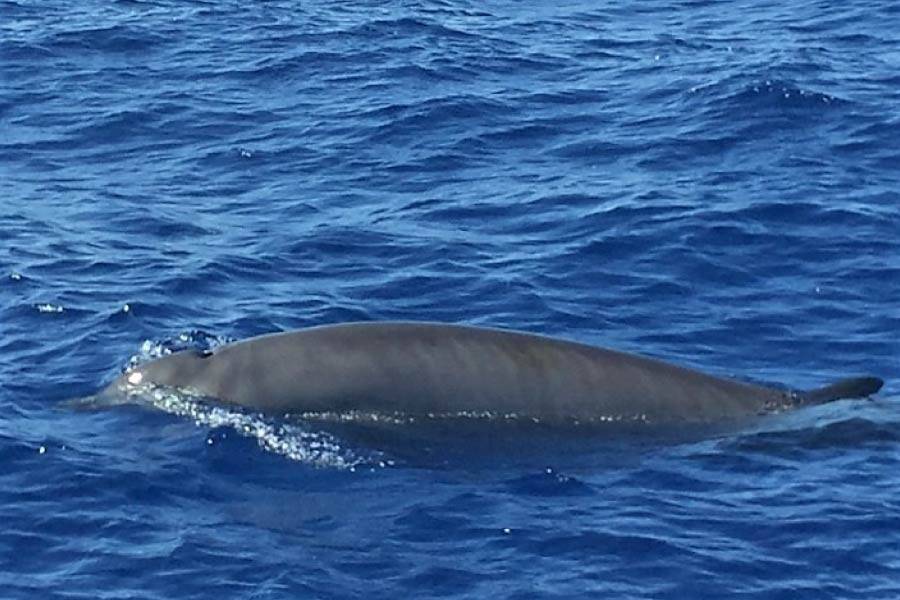
Scientific name: Mesoplodon europaeus
Family: Ziphiidae
Suborder: Odontoceti
Conservation status: Least Concern
Where found: Atlantic Ocean, particularly around the West Indies and the Canary Islands
Length: 4.5-5.2m / 14.7-17ft
Weight: 1000-1200kg / 2205-2646lb
Gervais’ beaked whale is a poorly known species of beaked whale. It has a slender, spindle-shaped body and a small dorsal fin. The species is often found stranded on the coasts of North America. Very few sightings of living individuals are known.
Ginkgo-Toothed Beaked Whale
No Image Available
Scientific name: Mesoplodon ginkgodens
Family: Ziphiidae
Suborder: Odontoceti
Conservation status: Data Deficient
Where found: Tropical and warm temperate waters of the Pacific and Indian Oceans
Length: 4.9-5.1m / 16-16.7ft
Weight: Unknown / Unknown
The ginkgo-toothed beaked whale is a rarely seen beaked whale. It gets its name from the shape of the male’s teeth, which resemble the leaves of a ginkgo tree.
Almost all that is known about this species comes from stranded specimens, as it is almost never seen at sea.
Gray Whale

Scientific name: Eschrichtius robustus
Family: Eschrichtiidae
Suborder: Mysticeti
Conservation status: Least Concern
Where found: Primarily in the North Pacific Ocean
Length: 12-15m / 39.4-49.2ft
Weight: 27,000-36,000kg / 59,524-79,366lb
The gray whale is a large baleen whale species known for its long-distance migrations, traveling between feeding and breeding grounds annually.
The species inhabits the waters of the North Pacific Ocean, with two primary populations recognized: the Eastern North Pacific population and the critically endangered Western North Pacific population.
Gray whales are easily identifiable by their mottled gray skin, which often hosts patches of whale lice and barnacles. Unlike many other whales, gray whales lack a dorsal fin and instead have a series of small humps along their back towards the tail flukes.
The gray whale is a bottom feeder with a diet consisting mainly of small crustaceans such as amphipods. The whale filters these from the mud of the sea bed with its baleen plates.
Gray’s Beaked Whale
No Image Available
Scientific name: Mesoplodon grayi
Family: Ziphiidae
Suborder: Odontoceti
Conservation status: Least Concern
Where found: Southern Hemisphere, primarily in cooler waters
Length: 5.5-5.7m / 18-18.7ft
Weight: 1100-1300kg / 2425-2866lb
Gray’s beaked whale, also known as the Haast’s beaked whale or scamperdown whale, is a species of beaked whale that predominantly inhabits the waters of the Southern Hemisphere, particularly around New Zealand and South Africa. It’s one of the larger members of the genus Mesoplodon, with adults reaching lengths of up to 5.7 meters.
The physical appearance of Gray’s Beaked Whale resembles that of other members of its family. It has a sleek, torpedo-shaped body and a distinctive long, slender beak, which is particularly pronounced in this species.
Like other beaked whales, Gray’s Beaked Whales are deep divers, capable of reaching great depths to forage for squid and fish. It is one of the most frequently stranded beaked whales in the Southern Hemisphere, often stranding in groups, one of which contained 28 individuals.
You can find out more about this species on this page: Gray Whale Facts
Hector’s Beaked Whale
No Image Available
Scientific name: Mesoplodon hectori
Family: Ziphiidae
Suborder: Odontoceti
Conservation status: Data Deficient
Where found: Southern Hemisphere, primarily in cooler waters
Length: 4.2m / 13.8ft
Weight: Unknown / Unknown
Hector’s beaked whale is a poorly known species of beaked whale, named after Sir James Hector, the curator of the Colonial Museum in Wellington, New Zealand. It has a robust body with a small, triangular dorsal fin.
Hubbs’ Beaked Whale
No Image Available
Scientific name: Mesoplodon carlhubbsi
Family: Ziphiidae
Suborder: Odontoceti
Conservation status: Data Deficient
Where found: North Pacific Ocean
Length: 4.9-5.2m / 16-17ft
Weight: Unknown / Unknown
Hubbs’ beaked whale is a rarely-seen species of beaked whale. It is recognized by its distinctive beak and white coloring on the front part of its body. Like other beaked whales, it is deep-diving and difficult to study due to its habitat and elusive behavior.
Humpback Whale
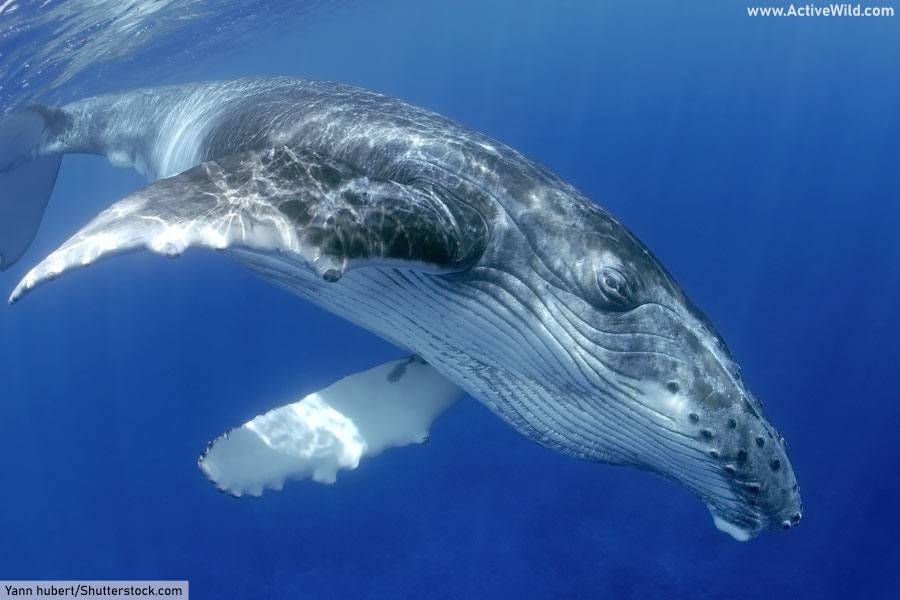
Scientific name: Megaptera novaeangliae
Family: Balaenopteridae
Suborder: Mysticeti
Conservation status: Least Concern
Where found: Oceans and seas worldwide
Length: 12-16m / 39.4-52.5ft
Weight: 25,000-30,000kg / 55,115-66,138lb
The humpback whale gets its name from the distinctive humped appearance of its back when it arches in preparation for a dive. This distinctive whale can also be recognized by its long, wing-like flippers and frequent breaching and other surface activity.
This iconic species is often the focus of whale-watching tours. Among the best places to see humpback whales include Alaska’s Glacier Bay National Park, Massachusetts’ Stellwagen Bank National Marine Sanctuary, California’s Monterey Bay, the Hawaiian Islands Humpback Whale National Marine Sanctuary, and Hervey Bay in Australia.
The humpback whale is known for the haunting song of the male. The exact purpose of the song is unclear, but it is believed to be part of the species’ mating behavior.
The humpback whale migrates up to 25,000 kilometers each year, from polar waters where it feeds, to tropical or subtropical waters where it breeds and gives birth.
You can find out more about this species on this page: Humpback Whale Facts
Narwhal
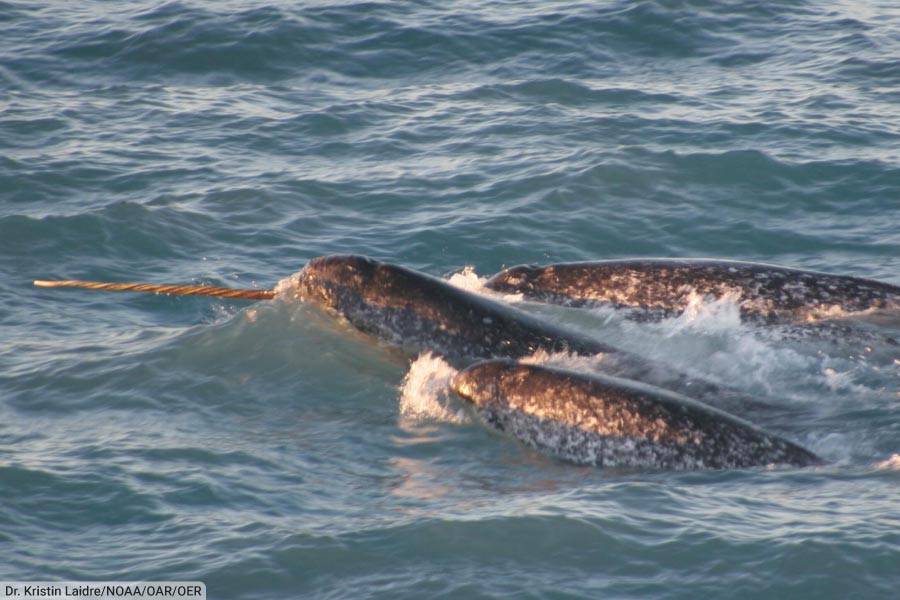
Scientific name: Monodon monoceros
Family: Monodontidae
Suborder: Odontoceti
Conservation status: Least Concern
Where found: Arctic waters around Greenland, Canada, and Russia
Length: 3.95-5.5m / 13-18ft
Weight: 800-1600kg / 1764-3527lb
The narwhal is known for long, spiraled tusk of the male. The tusk, which is actually an elongated tooth, can grow up to 3 meters in length. Narwhals spend their lives in Arctic waters, where they hunt for fish, squid, and shrimp.
The narwhal belongs to the family Monodontidae, the only other member of which is the beluga whale.
North Atlantic Right Whale
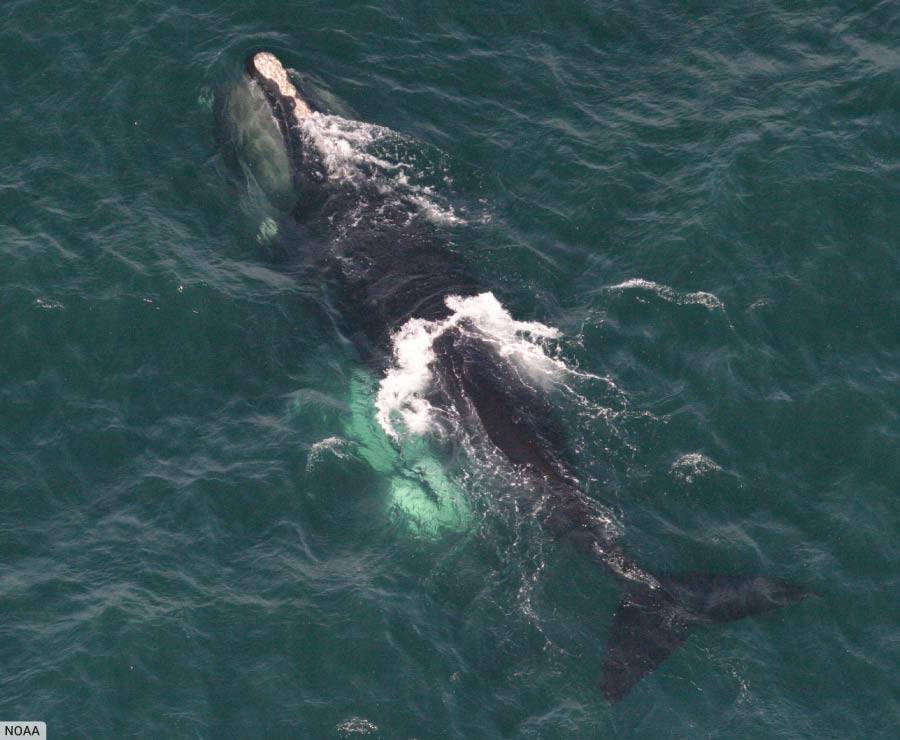
Scientific name: Eubalaena glacialis
Family: Balaenidae
Suborder: Mysticeti
Conservation status: Critically Endangered
Where found: Western North Atlantic, from Florida to the Gulf of St. Lawrence
Length: 11-18m / 36-59ft
Weight: 40,000-70,000kg / 88,185-154,324lb
The North Atlantic right whale is one of the world’s most endangered large whale species, with a population currently numbering under 500. It has a stocky body, no dorsal fin, and distinctive callosities on its head. The species is a slow swimmer, averaging 6 km/h (3.7 mph).
The North Atlantic right whale is one of three species of right whale (the others being the North Pacific right whale and the Southern right whale).
It is said that right whales are so-named because they were the “right” species to hunt, being slow-swimming with large amounts of blubber, although this explanation has been put in doubt by some authorities.
Right whales were hunted almost to extinction when the whaling industry was at its peak.
You can find out more about this species on this page: North Atlantic Right Whale Facts
North Pacific Right Whale

Scientific name: Eubalaena japonica
Family: Balaenidae
Suborder: Mysticeti
Conservation status: Endangered
Where found: North Pacific Ocean
Length: 15-18m / 49-59ft
Weight: 50,000-80,000kg / 110,231-176,370lb
The North Pacific right whale is a baleen whale similar in appearance to its Atlantic cousin. It has a broad, flat back with no dorsal fin and large, triangular flippers. This species was heavily targeted by commercial whalers in the past, and its population remains small today.
Northern Bottlenose Whale
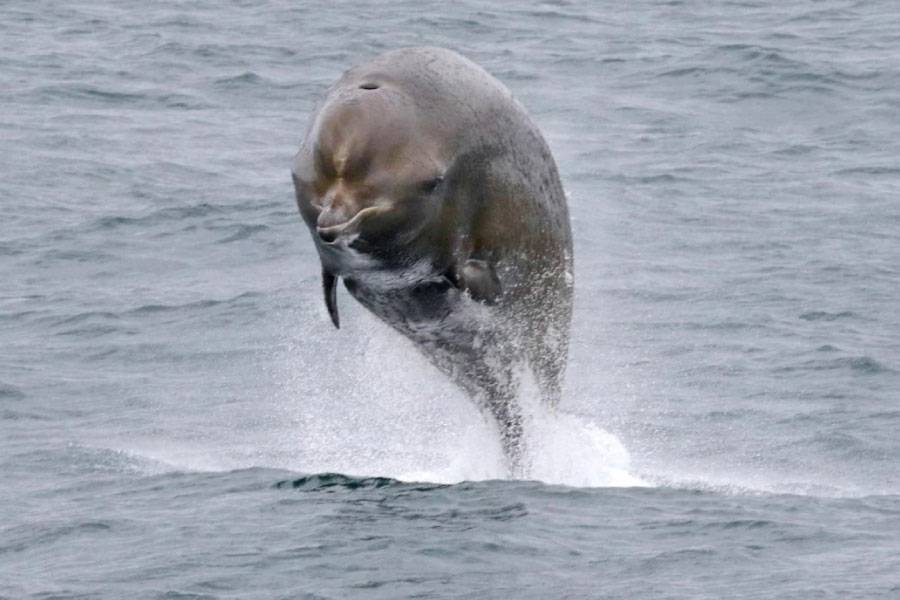
Scientific name: Hyperoodon ampullatus
Family: Ziphiidae
Suborder: Odontoceti
Conservation status: Near Threatened
Where found: North Atlantic Ocean
Length: 6-9.8m / 20-32ft
Weight: 5,800-7,500kg / 12,786-16,535lb
The northern bottlenose whale is known for its distinctive bulbous forehead, or melon, and long, tube-like beak. It one of the deepest-diving whales, known to reach depths of up to 2,339 m / 7,674 ft. in dives that can last for over two hours. The species is known for its curiosity towards boats, which unfortunately made it easy prey for hunters in the past.
Omura’s Whale
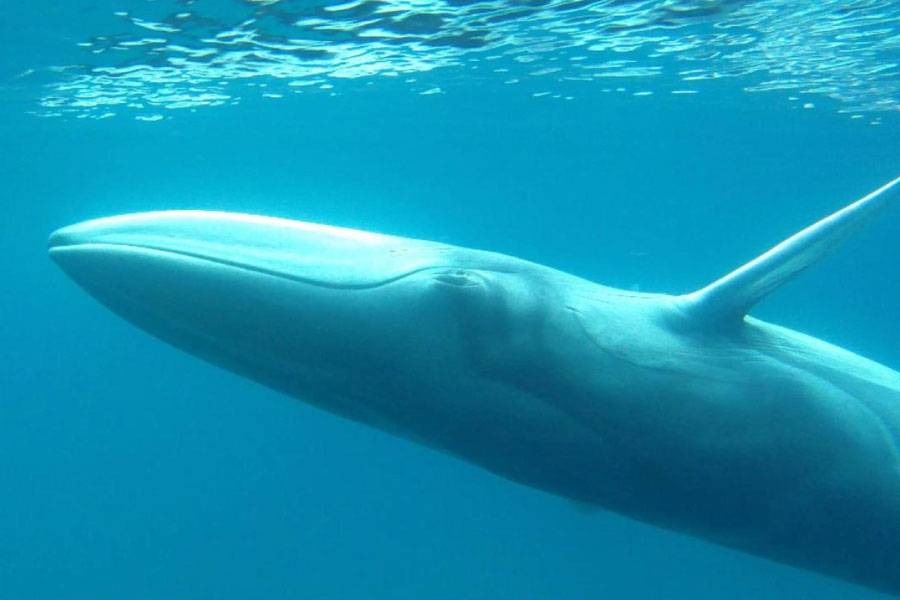
Scientific name: Balaenoptera omurai
Family: Balaenopteridae
Suborder: Mysticeti
Conservation status: Data Deficient
Where found: Indian Ocean and western Pacific Ocean
Length: 10-11.5 m / 33-38ft.
Weight: 4,536-9,072 kg / 10,000-20,000 lb
Omura’s whale is a relatively small baleen whale species that was formally recognized by scientists in 2003. The species is named after Japanese cetologist Hideo Omura.
Omura’s whale is characterized by its sleek, slender body with a distinct ridge running down its back to the dorsal fin. The left and right sides of the species’ lower jaw are asymmetrically-colored, with the right side being lighter than the left side. It also has asymmetrically-colored baleen plates, with the right baleen being white and the left being dark, which is thought to be associated with their feeding behavior.
Omura’s whale is primarily found in tropical and subtropical waters around the coastlines of the Indian Ocean and the western Pacific Ocean. It is often sighted alone or in small groups, and much of its behavior and lifestyle, including migration and breeding patterns, remains a mystery due to the species’ elusive nature and its relatively recent scientific recognition.
Perrin’s Beaked Whale
No Image Available
Scientific name: Mesoplodon perrini
Family: Ziphiidae
Suborder: Odontoceti
Conservation status: Endangered
Where found: Eastern North Pacific Ocean
Length: 4-4.5m / 13-14.8ft
Weight: Unknown / Unknown
Perrin’s beaked whale is a rarely-seen beaked whale species. It was only recognized as a separate species in 2002. Virtually all that is known about this species comes from strandings, as it is almost never seen in the wild. Like other beaked whales, it is likely a deep diver.
Pygmy Beaked Whale
No Image Available
Scientific name: Mesoplodon peruvianus
Family: Ziphiidae
Suborder: Odontoceti
Conservation status: Least Concern
Where found: Eastern tropical Pacific Ocean
Length: 3.9-4.2m / 12.8-13.8ft
Weight: Unknown / Unknown
The pygmy beaked whale is the smallest species of beaked whale. It is known from a small number of strandings and at-sea sightings. Like other beaked whales, it is deep-diving and elusive, which makes it challenging to study.
Pygmy Right Whale
No Image Available
Scientific name: Caperea marginata
Family: Neobalaenidae
Suborder: Mysticeti
Conservation status: Least Concern
Where found: Southern Hemisphere
Length: 6-6.5m / 19.7-21.3ft
Weight: 3,000-3,500kg / 6,614-7,716lb
The pygmy right whale is the smallest of the baleen whales. It is characterized by a small, narrow rostrum (snout) and a falcate (sickle-shaped) dorsal fin. The species is very rarely seen at sea; most of what is known about it comes from strandings.
Pygmy Sperm Whale

Scientific name: Kogia breviceps
Family: Kogiidae
Suborder: Odontoceti
Conservation status: Least Concern
Where found: Worldwide in tropical and temperate seas
Length: 3.5m / 11.5ft
Weight: 400kg / 882lb
Smaller than a bottlenose dolphin, the pygmy sperm whale is one of the smallest species of toothed whales. Until 1998, it was considered the same species as the dwarf sperm whale; both species belong to the family Kogiidae.
Like the dwarf sperm whale and sperm whale, the pygmy sperm whale produces a waxy substance known as spermaceti in an organ in its head. This is thought to aid echolocation, which likely plays an important part in hunting.
Like those of other sperm whales, the blowhole of the pygmy sperm is located on the left side of its head.
Sato’s Beaked Whale

Scientific name: Berardius minimus
Family: Ziphiidae
Suborder: Odontoceti
Conservation status: Near Threatened
Where found: North Pacific Ocean
Length: 6.9 m / 22.64 ft
Weight: Unknown
Little is known about Sato’s Beaked Whale, which is the smallest member of the giant beaked whale / four-toothed whale genus Berardius. This species was only formally recognized and named in 2019 following detailed genetic and morphological analysis.
The species was named after Hal Sato, a researcher who helped identify the species.
Like other beaked whales, Sato’s beaked whale has a distinctive beak, streamlined body, and a dorsal fin set relatively far back on the body.
Sei Whale
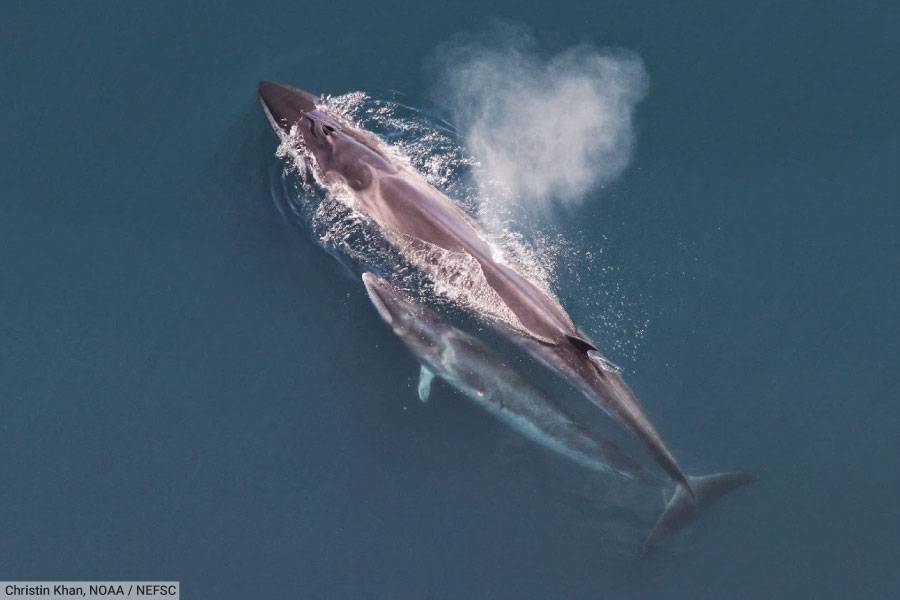
Scientific name: Balaenoptera borealis
Family: Balaenopteridae
Suborder: Mysticeti
Conservation status: Endangered
Where found: Worldwide in deep, offshore waters
Length: 14-20m / 45.9-65.6ft
Weight: 20,000-30,000kg / 44,092-66,139lb
The sei whale is a baleen whale, the third-largest rorqual whale after the blue whale and the fin whale. It has a streamlined body that is dark grey or blue-grey in color with paler markings on its underside.
Other distinguishing features of the sei whale are: a single ridge extending from the blowhole to the tip of the snout; tall, falcate (sickle-shaped) dorsal fin located about two-thirds down the back; and baleen plates that are dark and quite fine, designed to filter small prey from the water.
The sei whale inhabits most oceans and adjoining seas, preferring deep offshore waters. It avoids polar and tropical waters and semi-enclosed bodies of water. Its diet consists mainly of krill and other small schooling fish, which it consumes both by skimming the water’s surface and by lunge feeding.
Like other baleen whales, the sei whale is known to undertake long migrations from cool and temperate feeding areas in the summer to warmer breeding areas in the winter.
Shepherd’s Beaked Whale
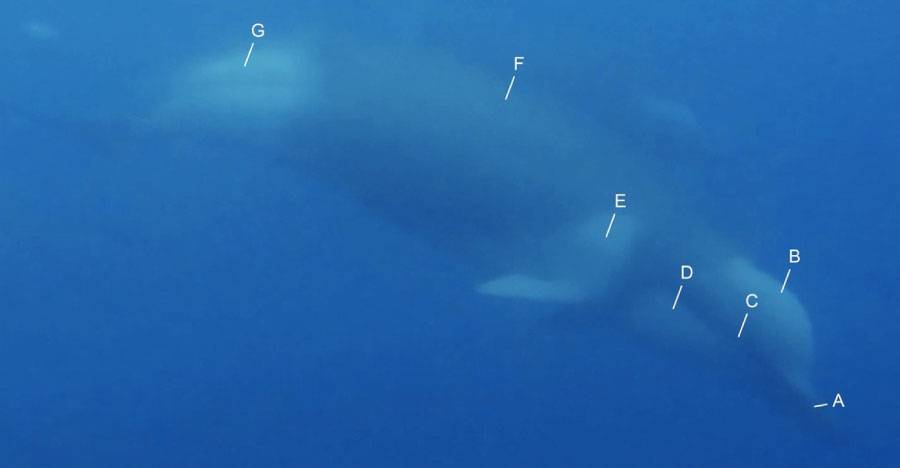
Scientific name: Tasmacetus shepherdi
Family: Ziphiidae
Suborder: Odontoceti
Conservation status: Data Deficient
Where found: Southern Hemisphere
Length: 6-7m / 19.7-23ft
Weight: 3,000-4,000kg / 6,614-8,818lb
Shepherd’s beaked whale is a unique species among the beaked whales as it is the only species known to have functional teeth in both jaws. It is also one of the few beaked whales that eats fish as well as cephalopods. Sightings of this rare whale species are few and far between; most of what we know about it comes from strandings.
Southern Bottlenose Whale

Scientific name: Hyperoodon planifrons
Family: Ziphiidae
Suborder: Odontoceti
Conservation status: Least Concern
Where found: Southern Hemisphere
Length: 7.5-8.2m / 24.6-26.9ft
Weight: 5,800-7,500kg / 12,786-16,535lb
The southern bottlenose whale is recognized by its large forehead and elongated beak. It is smaller than its cousin, the northern beaked whale.
One of the better-studied species of beaked whales, the southern bottlenose whale is often seen in groups, and is known for its deep dives to hunt squid and krill. It is one of the most frequently-sighted beaked whales in the Antarctic Circle.
Southern Right Whale

Scientific name: Eubalaena australis
Family: Balaenidae
Suborder: Mysticeti
Conservation status: Least Concern
Where found: Southern Hemisphere
Length: 14-18m / 45.9-59.1ft
Weight: 60,000-80,000kg / 132,277-176,370lb
The southern right whale is a large baleen whale with broad, paddle-like flippers and a wide back that lacks a dorsal fin. Found in the cold waters of the Southern Hemisphere, it closely resembles its cousins the North Atlantic right whale and the North Pacific right whale; the three closely-related species were once thought to be a single species.
Together, three right whales make up the genus Eubalaena.
The southern right whale has a tendency to approach boats closely, often interacting with them for extended periods, which makes it a popular species for whale-watching.
Sowerby’s Beaked Whale
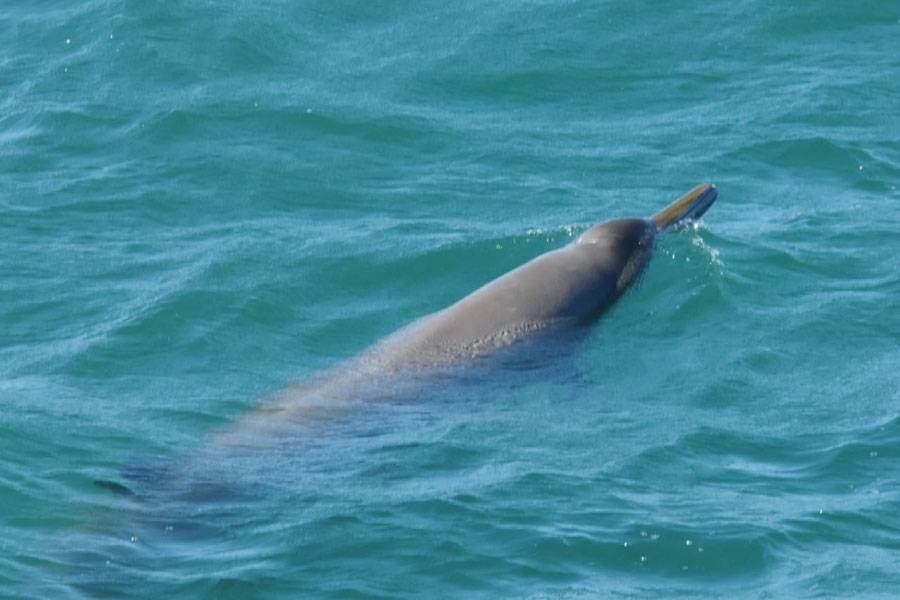
Scientific name: Mesoplodon bidens
Family: Ziphiidae
Suborder: Odontoceti
Conservation status: Least Concern
Where found: North Atlantic Ocean
Length: 5.5m / 18ft
Weight: 1,250-1,400kg / 2,755-3,086lb
Named after the English naturalist James Sowerby, Sowerby’s beaked whale is a medium-sized species of beaked whale found in cold waters of the North Atlantic. Like other beaked whales, it has an elongated, dolphin-like beak, rotund body, and a notched tail fluke.
Sowerby’s beaked whale is a deep diver, known to dive to depths of over 1km. Unlike most other beaked whales, it primarily hunts fish, rather than squid.
Spade-Toothed Whale
No Image Available
Scientific name: Mesoplodon traversii
Family: Ziphiidae
Suborder: Odontoceti
Conservation status: Data Deficient
Where found: South Pacific Ocean
Length: 5.5m / 18ft
Weight: 1,400 kg / 3,086.47 lb
The spade-toothed whale is a dolphin-sized beaked whale found in the southern Pacific Ocean. This seldom-seen animal is one of the world’s rarest cetaceans.
Until 2010, when a mother and calf were stranded in New Zealand, the species was known only from a few bone samples.
The spade-toothed whale’s name derives from the shape of its teeth, which are curved and spade-like, and visible only in males. The male’s teeth are around 23 cm (9 in) in length.
Sperm Whale
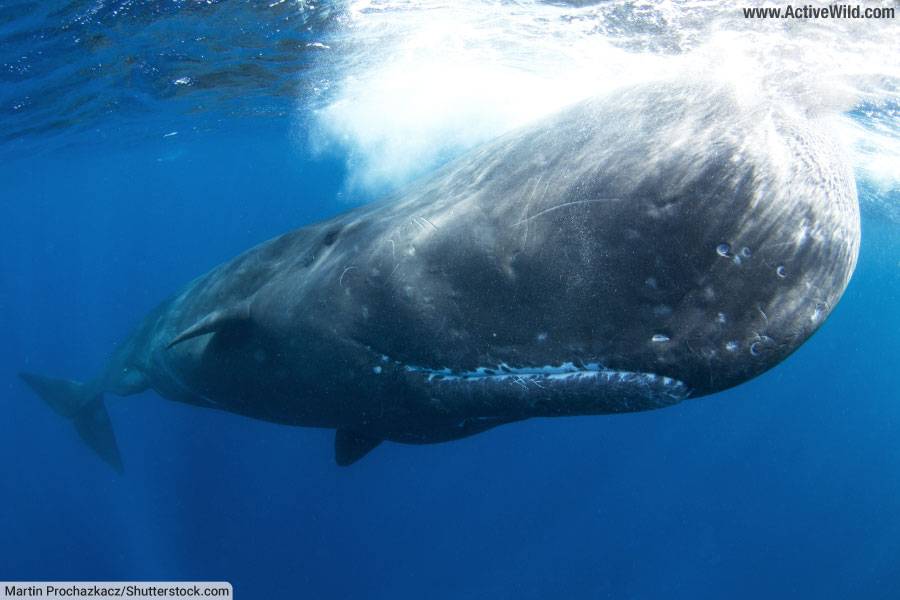
Scientific name: Physeter macrocephalus
Family: Physeteridae
Suborder: Odontoceti
Conservation status: Vulnerable
Where found: Worldwide
Length: 11-20.5m / 36-67.3ft
Weight: 25,000-45,000kg / 55,116-99,208lb
The sperm whale is not just the largest of the toothed whales, it is also the world’s largest toothed predator. The species is famous for its deep dives, staying submerged for about an hour and reaching depths of up to 2,000 meters / 1.24 Miles.
The sperm whale is easily recognized due to its block-shaped head. Produced by an organ within a sperm whale’s head is a substance called spermaceti, which was once used in oil lamps and lubricants. The species was once targeted by whalers for its spermaceti and blubber.
The fictional “white whale” Moby Dick that featured in Herman Melville’s novel of the same name was a sperm whale.
You can find out more about this species on this page: Sperm Whale Facts
Stejneger’s Beaked Whale
No Image Available
Scientific name: Mesoplodon stejnegeri
Family: Ziphiidae
Suborder: Odontoceti
Conservation status: Near Threatened
Where found: North Pacific Ocean
Length: 5.3-5.5m / 17.4-18ft
Weight: 1,300-1,400kg / 2,866-3,086lb
Stejneger’s beaked whale, also known as the “saber-toothed whale”, is characterized by its elongated beak and the two prominent teeth of the male that protrude upward and backward from the lower jaw.
Stejneger’s beaked whale is known to be a deep diver, like most beaked whales. Also like other members of its family, Stejneger’s beaked whale frequently bears the scars caused by bites from the cookiecutter shark.
Strap-Toothed Whale (Layard’s Beaked Whale)
No Image Available
Scientific name: Mesoplodon layardii
Family: Ziphiidae
Suborder: Odontoceti
Conservation status: Least Concern
Where found: Circumpolar in cool temperate Southern Hemisphere waters
Length: 5.9-6.2m / 19.4-20.3ft
Weight: 1,000-1,300kg / 2,204-2,866lb
The strap-toothed whale, also known as Layard’s beaked whale, is unique among cetaceans for the male’s pair of long, strap-like teeth that curl up and over the upper jaw. The species’ long teeth may actually prevent its beak from fully opening, potentially limiting the size of prey it can consume.
Typically for members of its family, the strap-toothed whale inhabits deep waters and is a deep-diver; its diet includes deep water squid, including the vampire squid, Vampyroteuthis infernalis.
Tropical Bottlenose Whale / Longman’s Beaked Whale

Scientific name: Indopacetus pacificus
Family: Ziphiidae
Suborder: Odontoceti
Conservation status: Least Concern
Where found: Tropical waters of the Indian and Pacific Oceans
Length: 7.6m / 25ft
Weight: Unknown / Unknown
The tropical bottlenose whale, also known as the Indo-Pacific beaked whale or Longman’s beaked whale, is a little-known cetacean that inhabits the warm waters of the Indian and Pacific Oceans.
Until the 1990s, the species was known only from two skulls. It is thought to inhabit deep offshore waters and to be a deep diver.
The tropical bottlenose whale is highly elusive, with most information about it coming from stranded specimens, making any sighting of this unique creature a momentous event.
True’s Beaked Whale
Scientific name: Mesoplodon mirus
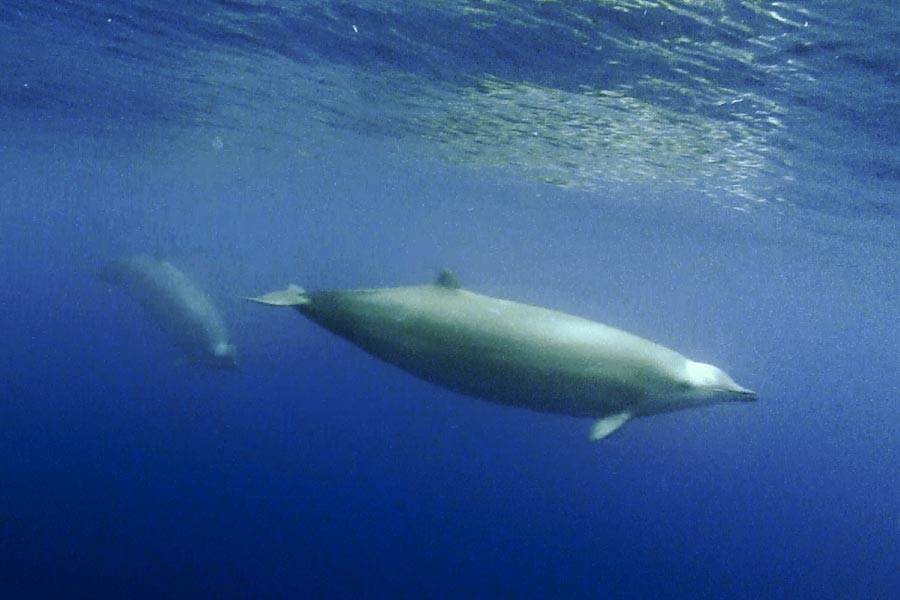
Family: Ziphiidae
Suborder: Odontoceti
Conservation status: Least Concern
Where found: North Atlantic Ocean and parts of the Southern Hemisphere
Length: 5.4m / 17.7ft
Weight: 1,400-1,500kg / 3,086-3,307lb
True’s beaked whale is a deep-diving whale found in the northern Atlantic Ocean. It is named after Frederick W. True (Wikipedia), a former curator at the United States National Museum. (True’s vole and True’s shrew mole also bear his name.)
True’s beaked whale is an elusive species, nearly always sighted in waters over 1,000 meters in depth. From stranded specimens, it is known that small fish feature predominantly in its diet.
Discover More With Active Wild
Discover more about whales and related sea animals on the following pages on Active Wild:
Visit our main animals page for links to animal information and a complete guide to the animal kingdom: Animals
You can see more ocean animals on this page: Ocean Animals List with Pictures & Facts
You can see pictures and facts on EVERY species of dolphin on this page: Types of Dolphins
Find out the difference between dolphins and porpoises: Dolphin Vs Porpoise
The post Types Of Whales: Pictures & Facts On Every Living Whale Species appeared first on Active Wild.